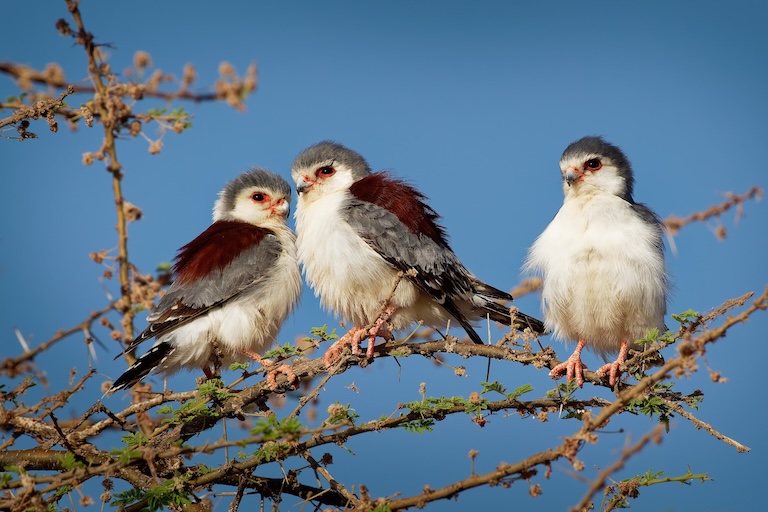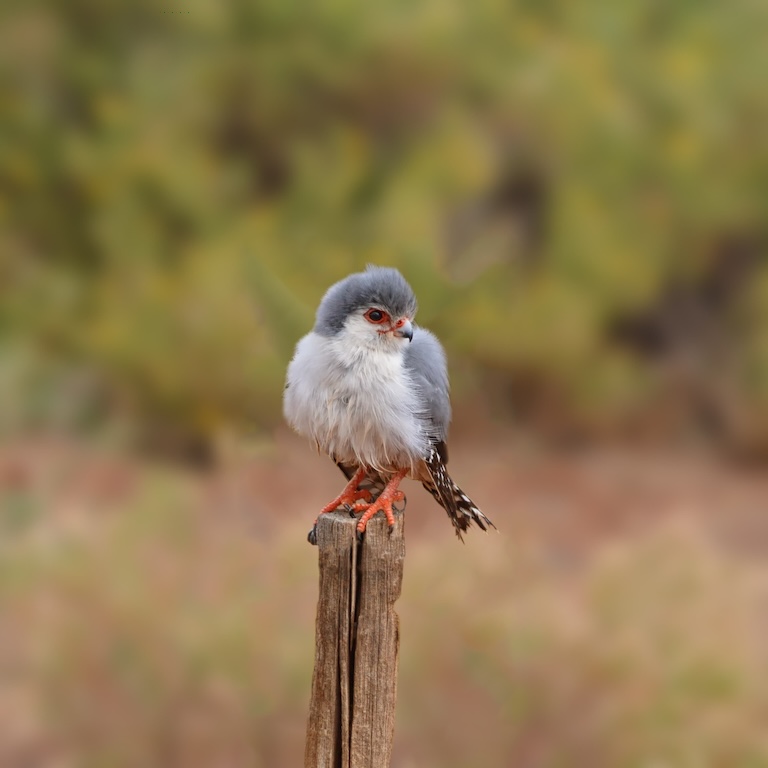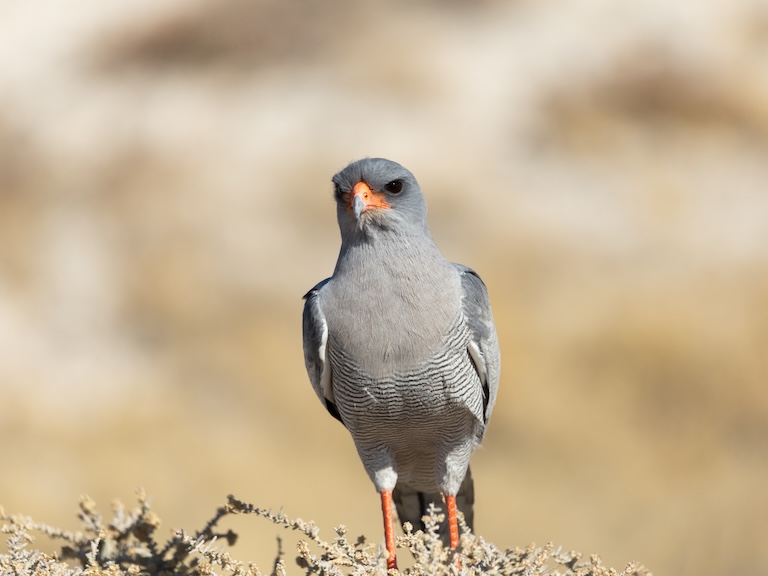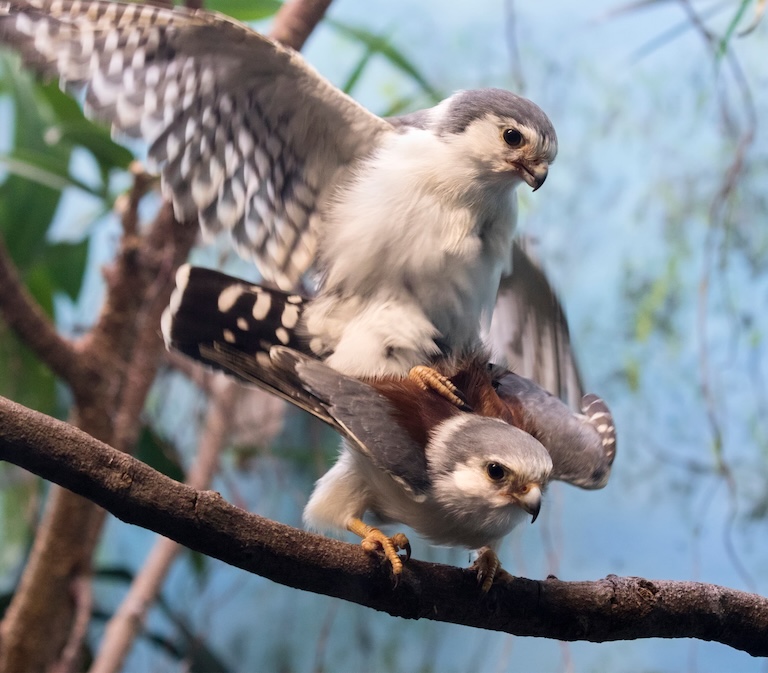Pygmy Falcon Profile
Dinosaurs have certainly fallen from grace in the last few (tens of millions of) years.
But while a lot of the giants have been replaced with warm-blooded mammals, the raptors still carry the torch as some of the most brutal and effective predators of mammals.
This is true even down to some of the smallest, and in Africa, that title goes to the Pygmy falcon, one of the smallest raptors in the world – but still very much a raptor.

Pygmy Falcon Facts Overview
| Habitat: | Dry brush |
| Location: | North-eastern and Southwestern Africa |
| Lifespan: | Around 8 years in the wild, up to 20 in captivity |
| Size: | 20 cm (7.9 in) |
| Weight: | 76 g (2.7 oz) |
| Colour: | Grey back (brown in juveniles), white front, with red eye rings. |
| Diet: | Reptiles, insects, small birds, small mammals |
| Predators: | Snakes, other raptors |
| Top Speed: | Unknown |
| No. of Species: | 1 |
| Conservation Status: | Least Concern (IUCN) |
Pygmy falcons are the smallest avian mammal killers in Africa, and this gives them the same sort of unsettling cuteness of an adorable killer that you might find in a domestic cat.
But these birds are more than just predators, they’re parasites, too, which makes them an interesting mix of opportunistic carnivores and ungrateful squatters
Interesting Pygmy Falcon Facts
1. They’re tiny!
The pygmy falcon is the smallest bird of prey on the African continent, and among the smallest raptors on Earth; only the Asian falconets and elf owls are smaller, and none of these are found in Africa.
These little birds are true falcons, in the Falconidae family; a taxon that includes the enormous Gyrfalcon – a ghostly, buzzard-sized raptor of up to 1.7kg.
At the other end of the spectrum are these little troopers: adult pygmy falcons weigh up to 76 g, and grow to about 20 cm long.
And being so tiny, they seek help from other birds to survive. Unfortunately, they don’t give a lot back in return. 1

2. They’re parasites
Parasitism is a fascinating world and a surprisingly common survival strategy for around half of all animal species.
We commonly think of parasites as the worms you get in your butt when you eat ambiguous roadside meat in the tropics or the ticks the dog brings in – and these are examples of parasitic animals, but that’s only one form.
Kleptoparasites steal food from other animals, brood parasites put their eggs in someone else’s nest, and hyperparasites feed on other parasites, giving them a taste of their own medicine.
The pygmy falcon doesn’t build its own nest and instead depends on the Social weaver, Philetairus socius. This behaviour is so common that inside around a quarter of all weaver nests in its range, you’re likely to find a pygmy falcon.
The weaver provides not only nesting locations but also thermal buffering, which involves the tiny falcon sitting in the middle of large gatherings of weavers to stay warm during the winter. 2
3. They use weavers to keep warm
The relatively barren landscapes these birds inhabit range in temperature quite a bit between the scorching daytime sun and the cold nights.
Some animals enter a state of torpor during cold times to reduce their body temperatures and save the energy that would be used to keep them warm. It’s likely pygmy falcons are capable of this, but they have a better strategy available to them too.
Setting their freeloading, feathered buts down amid large groups of weavers, they get to buffer themselves against the cold air and perhaps gain something from the thermal insulation brought about by their little warm bodies.
These weavers are the unwitting, obligate hosts of the parasitic weaver, and the relationship is very one-way already, but when breeding comes along, all bets are off. 3 4

4. Then they eat them
You’d think all these perks the falcon gets from weavers would inspire a form of gratitude, but unfortunately, it’s quite the opposite.
During mating season, bonded pairs make use of the chambers they’d been using as a roost to create their nests. This period is when they appear to get a taste for weaver flesh, as the weaver birds themselves come to inspect chambers for their potential as nesting sites.
Unfortunately for many weavers, if these holes happen to be occupied by the falcons, they often become lunch. 5
5. They wag their tails
While bad news for the weavers, the falcons happily get on with doing the needful, which for many birds involves a complex and difficult courtship display.
Not for the pygmy falcon, however, whose ritual is a lot simpler., and in many ways resembles that of the human mating routine:
First, the male sits on a perch next to the female. Then, the female silently wags her tail to signify her DTF status. The male obliges and mounts her. Now they both make sex noises before the male hops off and the female remains in position as if she could have done with a bit longer.
Unfortunately, that’s all the male has in him and he leaves the perch to enter the nest. The female soon follows, chattering.
No more than three weeks later, a clutch of between two and four eggs is laid.
6. They swing both ways
There are several coagulations of zealots who would hate to hear this, but homosexuality is pretty widespread through the animal kingdom in its various forms and comes in really handy.
The pygmy falcon is a great example of why it’s evolutionarily beneficial to be at least a bit gay, and why it’s a natural part of survival that’s been passed on genetically.
When one member of a bonded pair gets lost or dies, or is otherwise missing, the remaining member will instantly shack up with another partner, regardless of their sex.
Pairing up with a same-sex mate will of course limit the chances of reproduction significantly, but it means that territories can be maintained and any offspring that’s already produced or on the way can have the same chance of survival.
7. They’re cooperative breeders too
This liberal approach to parenting extends to the offspring of their neighbours, too. While pygmy falcons are deeply selfish in dealing with weavers, they are very compassionate to their own kind and show a high rate of cooperative breeding.
Most of the documented cases involve offspring from the previous year helping to rear the next generation, but others are just adults passing through. Territories can involve multi-male or multi-female groups or both, all of whom take turns looking after the young.

Pygmy Falcon Fact-File Summary
Scientific Classification
| Kingdom: | Animalia |
| Phylum: | Chordata |
| Class: | Aves |
| Order: | Falconiformes |
| Family: | Falconidae |
| Genus: | Polihierax |
| Species: | semitorquatus |
Fact Sources & References
- The Cincinnati Zoo & Botanical Garden (2020), “Home Safari – African pygmy falcon – Tanzi – Cincinnati Zoo”, YouTube.
- “African Pygmy Falcon”, San Diego Zoo Wildlife Alliance.
- Covas, R., Huyser (2009), “Pygmy Falcon predation of nestlings of their obligate host, the Sociable Weaver”, Taylor & Francis.
- Jess Lund (2020), “Winter thermoregulation in free-ranging pygmy falcons in the Kalahari Desert”, Springer Nature Link.
- G. L. Maclean (1970), “The Pygmy Falcon Polihierax Semitorquatus”, Research Gate.
